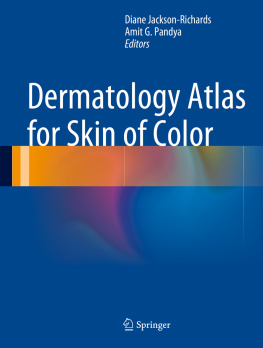1. The Anthropology of Skin Colors: An Examination of the Evolution of Skin Pigmentation and the Concepts of Race and Skin of Color
Skin color is a conspicuous trait of biological and social importance. The associations of skin color with concepts of human races and social privilege in recent human history have added to the significance, as well as to the misunderstanding of the trait, in general society and in medicine. In this chapter, I present a short review of what we know about human skin color in its evolutionary and social contexts. Examination of the evolution of the diversity of skin color is an essential foundation because it informs our understanding of biological and social concepts of race, and of the validity of the concept of skin of color.
The Evolution of Naked Skin and Skin Pigmentation in the Human Lineage
Most of the surface area of the human body except for the scalp, axillae, and groin is covered with functionally naked skin. The vellus hairs that emerge from hair follicles are placeholders in maintaining the integrity of the follicle, but do not serve the purposes of the terminal hairs that covered our distant hominin (Hominin refers to the group consisting of modern humans, extinct human species, and all immediate ancestors belonging to the genera Homo , Australopithecus , Paranthropus , and Ardipithecus .) and primate ancestors. The evolution of hair loss in the human lineage has been discussed extensively in the literature and is reviewed elsewhere []. This denotes that protective eumelanin-rich constitutive pigmentation has persisted because of its contribution toward the survival and successful reproduction of populations living under high UVR at low latitudes.
Extremely high correlations exist between skin pigmentation (as measured by skin reflectance) and levels of minimal erythema dose UVR (UVMED), with skin color being almost fully modeled as an effect of autumn UVMED alone ( r = 0.927; P < 0.0001) [].
The most strongly and consistent supported hypothesis is that dark pigmentation evolved in the functionally naked skin of early Homo to help protect against photodegradation of cutaneous and systemic folate under high UVR conditions. The physiological effects of photodegradation of folate were explored long before the full extent of folates roles in DNA biosynthesis, repair, DNA methylation, amino acid metabolism, and melanin production were appreciated []. Maintaining the integrity of folate metabolism is important with respect to evolution because it directly affects reproductive success and survival early in life. Natural selection has, thus, affected varied genetic and physiological mechanisms in order to protect folate and 5-MTHF in the face of high UVR. The primary role of dark constitutive skin pigmentation in hominin and modern human evolution is that of a natural sunscreen to conserve folate.
The Evolution and Dispersal of Homo sapiens and Its Consequences for Skin Pigmentation
The key events in the human lineage occurred in equatorial Africa under conditions of intense and relatively invariant sunlight and UVR. Dispersal of hominins into non-equatorial Africa and Eurasia involved movements out of UVR-saturated environments into habitats that were more mixed with respect to the seasonal pattern, intensity, and wavelength mixture of UVR []. There is no evidence to suggest that Homo erectus or early Homo sapiens used sewn clothing or other methods of full-coverage protection against the sun and elements. Thus, apart from the time they spent in the shade or in natural shelters, their bodies were subjected to the full force of UVR wherever they went. Skin was the primary interface with the environment for most of human evolution.
In order to understand the nature of the selective pressures facing hominins as they dispersed out of the tropics, some more information on UVR is needed. The biological activity of UVR varies according to wavelength [].
The eumelanin in skin is a highly effective sunscreen, and the potential for cutaneous vitamin D3 production is reduced by dark skin. Other things being equal, the higher the eumelanin content, the lower the rate of pre-vitamin D3 production in the skin [].
The importance of the evolution of depigmentation for hominins living under non-tropical regimes was inferred before genomic evidence was available [].
There has been a cause and effect relationship between UVR and skin pigmentation in human evolution. Skin pigmentation phenotypes have been modified under the action of natural selection to maintain an optimum balance between photoprotection and photosynthesis over spatially varying conditions of UVR. Skin color thus evolved as the product of two opposing clines, one emphasizing dark pigmentation and photoprotection against high loads of UVA and UVB near the equator, the other favoring depigmented skin to promote seasonal, UVB-induced photosynthesis of vitamin D3 nearer the poles []. New combinations of pigmentation genes are being made every day as modern people move around the world over long distances and mate with one another. Many of the resulting skin color phenotypes are visually indistinguishable from one another. This does not mean that there may not be minor differences discernible by reflectometry or in physiological response to UVR challenge. But the palette of skin color genes in humans is highly redundant, and there are many genetic ways to produce virtually identical phenotypes. This fact has profound implications for our understanding of the concepts of race and skin of color.
Skin Pigmentation Evolution Invalidates the Concept of Color-Based Race and Suggests That Skin of Color Is an Outdated and Inaccurate Concept
The question is often asked, how does an understanding of the biology and the evolutionary basis of skin color diversity contribute to our understanding of the concepts of race and skin of color? The answer is simple, but it is sometimes not what questioners expect or want to hear.
For as long as the concept of race has existed, it has been messy and ill defined. From its beginnings in the sixteenth century, race was a concept that was associated with some characteristics of physical difference, primarily those of skin color, along with characteristics of temperament and capacity for culture and moral judgement [] and what is clear is that so-called scientific theories of race were anything but. They were pseudoscientific justifications for racism and rationalizations for the maintenance of the lucrative transatlantic slave trade.
Biologists and anthropologists long recognized the inutility and invalidity of the biological race concept []. The evidence presented in this review indicates that color-based concepts of race are entirely obsolete because people with identical skin color phenotypes can be genetically entirely different. Despite these facts, clinicians and forensic scientists generally have retained racial categoriesalong with a belief in the validity of racesbecause race labels have been a part of medical and legal practice in the U.S. and many other countries for more than a century. Many health-related granting organizations require that human subjects be identified by race or ethnicity in order to be entered into clinical studies or trials, and also stipulate that investigators report results accordingly. Race and ethnicity lack inherent biological meaning because they are nonexclusive and are defined by cultural and linguistic characteristics, but they continue to be recycled and revalidated in the medical, forensic, and pharmacological literature, out of habit and usually without question or justification.













